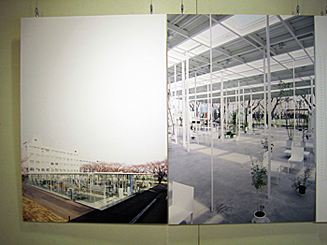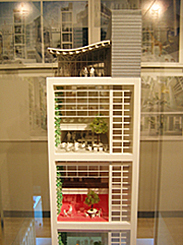 |
|
 |
Dramatic images of the KAIT Workshop
by Junya Ishigami received the top honor. |
|
Detailed model of Shigeru Ban's Nicolas G. Hayek Center, Swatch Group Headquarters, Ginza, Tokyo. |
|
|
Located in an unassuming, tile-clad seven-story building in Tamachi, Tokyo is the Architectural Institute of Japan, a non-profit academic association. One might easily mistake the institute for an insurance company or ward office. It houses a library, hall, and conference rooms for the purpose of collection preservation, restoring and researching architectural materials such as drawings, models and photographs. Every year the AIJ, which boasts over 38,000 members, recognizes excellence in research, building engineering, education and design. Three top prizes were given this year in the area of design as well as eleven design commendations. The exhibition is being held until June 5 in the surprisingly accessible two-room gallery space just off the lobby. Three projects receiving the top honor -- each very different from the other -- are on display in the main space.
The KAIT Workshop is a single-story glass pavilion on the Kanagawa Institute of Technology campus in Atsugi, southwest of Tokyo. This is the first project realized by emerging architect Junya Ishigami since starting his practice in 2004. The light roof enveloped by a glass façade evokes a quiet, ethereal simplicity. Upon further inspection, however, this 2,400 square meter structure is anything but simple. Over 300 thin white columns, of which 290 are entirely unique in shape and orientation, appear to be randomly placed. Ishigami insists that the columns are, in fact, deliberate -- the result of tireless structural calculations and design iterations. Regardless, such overworking trumps the building's first impression.
Manabu Chiba's Japan Guide Dog Center "Fuji Harness" is a series of shed-roofed rectilinear volumes laid out in a strict orthogonal grid. Currently an associate professor at the Graduate School of Engineering, University of Tokyo, his approach is refreshingly unaffected and free of extraneous details. The voids become courtyards within the simple building forms articulating their layout on the vast site. Each building in the otherwise plain wood model on display is painstakingly labeled in Braille for its users.
Another highly detailed model in the exhibition is that of Shigeru Ban's Nicolas G. Hayek Center. The new 14-story headquarters building for Swatch Group Japan is located on a narrow slot of a site in Tokyo's Ginza district. The building houses customer services, offices and a spa, as well as a retail shop for each of the seven distinct brands within the Swatch Group. Each brand has its own hydraulic glass elevator serving as a mini-showroom and giving direct access to its respective shop. A series of four-story operable shutters allow the front and back façades to be open or closed. The building feels perfectly appointed for its context, bringing the grandness of Tokyo's most elite shopping district down to human scale.
The Architectural Institute of Japan states that its main purpose is to "cultivate its members' abilities and heighten architectural quality in Japan." For a visitor to this award exhibition, it was unclear who juried the program, the judging criteria or the number of entries submitted. Entrants were asked to submit two A1-sized boards showing a recently built project. Such a format allows the jury to easily compare the projects but results in a static exhibition. Fortunately the individual entries themselves, including the eleven commendation prizes, were dynamic on their own and well worth the visit.
|